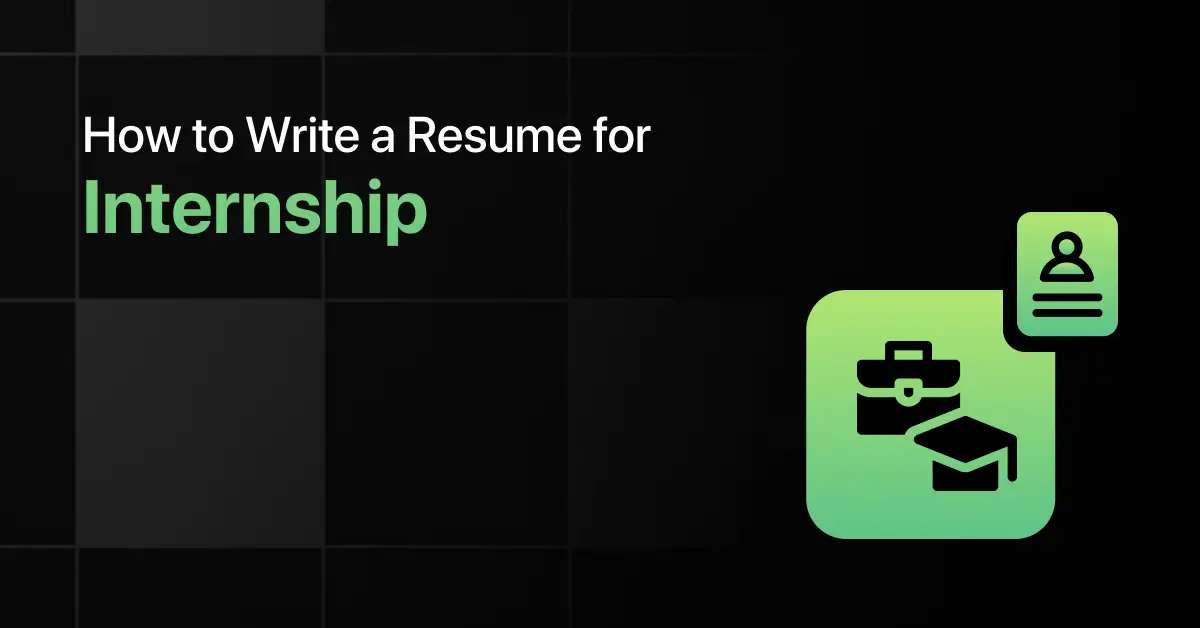How to Write a Resume for Internship

Breaking into the job market is never easy, and no matter how prepared one might feel, the pressure and uncertainty are real. Every year, over 3 million graduates in India begin their job search, yet only about half manage to secure employment. This wide gap exists largely because many graduates are either not aligned with industry expectations or struggle to present their skills, especially through their resumes, effectively.
An internship often serves as the first step into this competitive job market, where your skills are tested, refined, and showcased in action. That’s why understanding how to write a resume for internship becomes essential. A well-crafted internship resume goes beyond listing your education; it highlights your potential, adaptability, and eagerness to learn. It acts as your professional introduction, opening doors to meaningful real-world experiences and future career opportunities.
Steps to Write a Resume for Internship
No, we’re not jumping straight into “5 hacks to land an internship.” This is your solid roadmap, a step-by-step process that helps you build a resume grounded in clarity, relevance, and impact.
By the end, you’ll know exactly how to make your application stand out for the right reasons.
Step 1 – Research the Organization and Job Description
Before writing a single line, start with research. Understand the company you’re applying to, its culture, values, and current projects. Then, carefully go through the job description to identify what skills and responsibilities the role emphasizes.
This clarity helps you tailor your resume instead of using a generic template. For instance, if the internship focuses on marketing analytics, highlight your coursework, tools, or mini-projects related to that area. The goal is to make your resume mirror what the organization is looking for.
Step 2 – Prepare Your Skill List
Next, list down all your technical, academic, and interpersonal skills. Then, sort them based on relevance to the internship you’re targeting. Employers value clarity and focus over volume, so they prioritize quality over quantity.
If you’re applying for a tech internship, include skills like Python, HTML/CSS, or version control tools like Git. For management or creative internships, emphasize communication, teamwork, and analytical abilities. This step ensures your resume is built on a strong foundation that matches both your strengths and the employer’s needs.
Step 3 – Craft Your Objective Statement
Your objective statement sits right at the top of your resume, and it sets the tone. Keep it short, specific, and goal-oriented. Avoid vague lines like “I’m seeking an opportunity to learn and grow”.
Instead, write something like:
“Aspiring data analyst seeking an internship at [Company Name] to apply data visualization and SQL skills in real-world problem-solving.”
This shows clarity of intent, relevance, and readiness.
Step 4 – Highlight Educational Qualifications
Your educational background is one of your strongest assets as a student or fresher. List your degree, college, university, and graduation year clearly. You can also include relevant coursework, academic projects, or certifications that relate to the internship role.
For example, if you’re applying for a UI/UX design internship, mentioning your elective in “Human-Computer Interaction” adds context and credibility.
Step 5 – Showcase Projects and Practical Work
Projects are your proof of skill. Include academic, personal, or hackathon projects that reflect hands-on experience. Use bullet points to describe what you built, how you built it, and the impact or outcome.
For example:
Developed a web-based student attendance tracker using React and Firebase, reducing manual entry time by 60%.
This demonstrates initiative, execution, and measurable results—traits employers value highly.
Step 6 – Include Achievements and Extracurricular Activities
Internship recruiters often look for well-rounded candidates. Add achievements, club roles, competition wins, or leadership experiences that show accountability and teamwork.
If you’ve participated in events, workshops, or community initiatives relevant to your field, mention them briefly. These experiences reflect discipline and curiosity, two key traits for interns.
Step 7 – Format and Proofread Professionally
Even a great resume can lose impact if it looks cluttered or contains errors. Use a clean layout with consistent font size, spacing, and section headers. Avoid large text blocks; make it easy to scan.
Before sending, proofread carefully for grammar, spelling, and alignment. You can even ask a mentor or friend to review it. Remember, your resume speaks before you do; make sure it represents your best self.
Tips to Make Your Internship Resume Stand Out
Once your resume is neatly structured, the next step is to make it memorable. Intern recruiters review hundreds of similar applications every week, so small details can make a big difference in setting yours apart.
Here are some simple ways to make your internship resume stand out:
1. Include References
Stepping into the job market becomes twice as easy when industry professionals support your credibility, such as your professors, mentors, or internship supervisors.
Add a short “References” section at the end of your resume with 1–2 contacts who can vouch for your skills and attitude.
Example:
Dr. R. Kumar – Assistant Professor, Computer Science, XYZ College – +91 9XXXXXXXXX
This gives recruiters an extra layer of trust and signals that your work ethic has been noticed by professionals.
2. Make It ATS-Friendly
Many students assume that internship resumes don’t go through any screening. In reality, most medium to large companies use Applicant Tracking Systems (ATS) even for internship roles.
That means your resume should be keyword-optimized and easy for software to read.
- Avoid tables, text boxes, or images.
- Use standard section headers like Education, Skills, Projects, and Certifications.
- Pick fonts like Arial, Calibri, or Roboto — not decorative ones.
A visually simple, text-based format ensures your resume passes both the machine and the human test.
3. Avoid Over-Decorating
A colorful or overly designed resume can actually hurt your chances. Recruiters prefer professional simplicity over flashiness.
Stick to black text, white background, and one consistent font throughout.
A clean design reflects clarity and discipline, traits that matter more than visual gimmicks.
4. Lead with Impact, Not Just Involvement
Most students describe what they did, not what came out of it. Recruiters remember results, not responsibilities.
Instead of: “Worked on a college project on machine learning.”
Write: “Built a machine learning model that improved classification accuracy by 17% in our final-year project.”
Tip: Begin each point with a strong verb (Built, Designed, Automated, Analyzed) and end with a measurable outcome. This transforms basic bullet points into proof of value.
5. Highlight Self-Initiated Projects or Challenges
Recruiters love self-starters. If you’ve ever built something beyond coursework, like a small app, GitHub repo, or automation tool, showcase it proudly.
It shows initiative, curiosity, and a problem-solving mindset. Even a simple “Independent Work” section makes your resume memorable.
Pro tip: Add brief context, like “Built a personal finance tracker used by 30+ peers to manage expenses.” That personal touch makes your work relatable.
6. Customize for Every Internship
The biggest turnoff for both humans and AI recruiters is a generic resume that looks copy-pasted.
Before applying, analyze the job description and make small but impactful adjustments.
If the role says “UI/UX exposure,” bring your design project to the top.
If it’s “data analytics,” highlight your SQL or visualization work first.
Example:
For a Data Analytics Internship:
“Analyzed survey data using Excel and Tableau to identify patterns in student engagement.”
For a UI/UX Internship:
“Redesigned college website prototype focusing on navigation flow and accessibility.”
Matching your bullets to the job helps you appear tailor-made for the role
7. Add a “Learning & Certifications” Section
Show recruiters that you’re serious about upskilling.
Include short, relevant mentions of your online certifications, hackathon participation, or workshops, but keep it crisp.
Example:
Completed GUVI’s Data Analytics Certification featuring 3 industry-grade projects.
This proves you’re not just learning academically, but practically, too.
Common Mistakes to Avoid in Internship Resumes
There is a high chance this could be the first time you’re crafting a resume. Recruiters know that, but what they expect from you is at least the basics done right: relevance to the role, a professional format, accurate details, and evidence that you’ve researched the company you’re applying to. They don’t expect a “perfect” resume, but they do expect one that looks like a genuine effort went into it.
Below are some common mistakes students often make while building their internship resumes:
1. Using vague or casual email IDs
Recruiters notice this instantly. A professional email ID with your name shows seriousness, while something casual looks careless.
Example:
Instead of [email protected] → Use [email protected]
2. Writing long paragraphs instead of bullets
Both ATS software and human recruiters scan resumes. Long text blocks make your achievements invisible. Use crisp bullets so key details stand out.
3. Copy-pasting job description keywords without context
Making your resume ATS-friendly is important. But stuffing keywords word-for-word without proof makes your resume robotic. Show how you’ve applied those skills in projects or coursework instead.
4. Listing unrelated part-time jobs without framing transferable skills
Roles like delivery agent or tuition teacher are valuable — but only if you connect them to workplace skills like time management, communication, or leadership. Otherwise, they seem irrelevant to the internship.
5. Leaving formatting inconsistent
Uneven fonts, misaligned bullets, and irregular spacing distract from your content. A clean, uniform design signals attention to detail.
6. Overloading with empty adjectives
Words like “hardworking,” “passionate,” or “dedicated” appear on nearly every resume. Without results or examples, they add little value. Replace them with action + outcome statements that prove those qualities.
7. Forgetting to include clear contact details
Missing phone numbers, half-visible email IDs, or misplaced LinkedIn links happen more often than you’d think. A recruiter won’t chase missing information.
8. Not naming the file properly
A file named resume_final(2).docx looks careless. Use a simple, professional format: Priya_Sharma_Resume.pdf.
9. Submitting in the wrong format
Sending a Word file (.doc) instead of a PDF risks breaking formatting on the recruiter’s system. Unless a company asks otherwise, always send resumes as PDFs.
Build Your Internship-Ready Resume Today
To make crafting your internship resume easier, try the GUVI Free Resume Builder — a smart, user-friendly tool that helps you build, optimize, and score your resume for ATS compatibility. With guided templates and instant feedback, it ensures your profile is clear, professional, and aligned with what recruiters are looking for. Start for free and polish your application in minutes. Create your internship-ready resume now!
Final Words
An internship resume is your first handshake with the professional world. The way you present your skills, projects, and intent decides if you move forward in the selection process. By tailoring your resume, avoiding overlooked mistakes, and showcasing impact over involvement, you position yourself as someone ready to contribute and learn.
Treat your resume as a living document that grows with every project, certification, or achievement, and it will continue opening doors to the opportunities you seek.
Frequently Asked Questions
1. How to write a resume for an internship with no experience?
Focus on academic projects, relevant coursework, certifications, extracurriculars, and self-initiated work. Emphasize skills, achievements, and measurable results wherever possible.
2. What sections should be included in an internship resume?
Include: Contact Information, Objective Statement, Education, Skills, Projects/Practical Work, Achievements & Extracurriculars, Certifications, and References (optional)
3. How do I highlight skills effectively on an internship resume?
List skills relevant to the role, categorize them (technical, interpersonal), and support them with examples from projects, internships, or coursework.
4. How many skills should freshers include in their resume?
Include 5–10 highly relevant skills. Quality matters more than quantity—prioritize clarity and relevance to the internship.
5. Should I include hobbies or unrelated experiences in my internship resume?
Only include hobbies or experiences if they demonstrate transferable skills such as leadership, teamwork, or problem-solving. Avoid irrelevant details that don’t add value.
Explore More Resume Articles
Related Posts


Soft Skills Training for College Students: Key Topics & Activities
Are you feeling out of your element preparing for campus placements in India? While there is plenty of discussion about …









